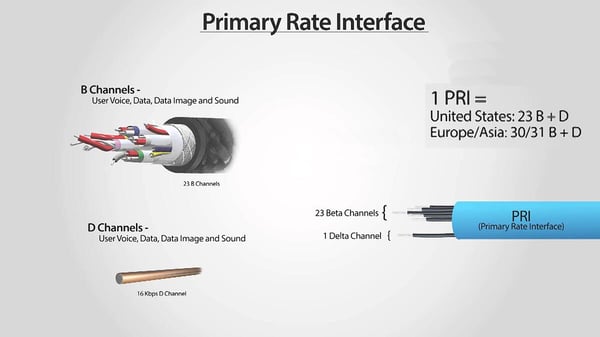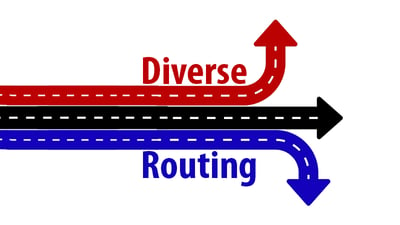Primary Rate Interface is used in the telecommunications industry to send voice and data transmissions over the Integrated Services Digital Network (ISDN). ISDN gives you better call quality and enables the transmission of data by making use of packet-switched networks.

Primary Rate Interface has become the standard for providing telecommunications to enterprises and offices due to its ability to provide high capacity services over T1 or E1 trunk lines – the main links connecting a phone to an exchange.
T1 vs E1 Trunk Lines
Typically used in the United States and Canada, T1 trunk lines (the lines transporting data signals) make use of 24 channels in total. One of the 24 channels is reserved to carry call information like caller ID – this is called the delta channel or “D Channel. ”The other 23 channels are known as bearer channels or “B Channels” and are left open to transmit voice data. The 23 B Channels are like having 23 individual phone lines.
On the other hand, E1 trunk lines are mainly used in Europe. Where T1 trunks only have 24 channels, E1 trunks have 32 total channels. Of the 32 channels, 2 are D Channels and the remaining 30 are B Channels.
[Read More: Diverse Routing - Utilizing PRI & SIP For Business Continuity]
PRIs: The Good 😄
Primary Rate interfaces are an end-to-end managed service that provides a lot of value once in place. They require an investment in fixed infrastructure but once that infrastructure is in place there are many benefits to reap from a primary rate interface.
- Reliability
Primary Rate Interface lines provide stability by being powered from the central office which allows them to stay up during power failures. They are also digital which makes troubleshooting any issues easy and efficient compared to analog trunk lines.
- Security
Analog trunk lines are a breeze to tap into without any technical knowledge. If you're on analog anyone can spy on you with a homemade bug that costs around $7 to make. Tutorials on how to do so are easily found on YouTube. The digital nature of PRIs provides an added layer of security and privacy to your communications.
- Speed
High-quality calls made over a primary rate interface are established much quicker due to their dedicated line structure.
- E911 Compliance
PRI environments allow for granular location information from a caller to be delivered to 911 call centers. This would include the caller's building address, the floor they're on, and subnets within that floor allowing for emergency responders to quickly and accurately locate the caller.
SIP trunk carriers often don't provide this granular information. This would be a problem on a college campus for example. If someone called 911 from a campus with SIP trunks, the 911 center would see that the call is coming from the college campus but NOT what building the call is coming from, what floor, etc.
- Straightforward billing
Your accounting department will thank you, with a primary rate interface you’ll receive one single bill rather than a bill for 23 individual phone lines.
PRIs: The Bad 😞
- Reliance on physical components
PRI’s require an investment in fixed infrastructure which can be expensive and time-consuming to set up. Every circuit will need a physical connection and hardware to terminate the connection. Due to this requirement, scaling your system up will mean installing additional hardware and new circuits.
Is PRI the solution for me?
Primary rate interface is not going to be the solution that best meets the needs of every organization. PRI is great if you're a heavy user of telephony services and prioritize top-notch call quality. Primary rate interfaces will provide you a quick connecting, secure, and reliable voice solution. This comes at the price of high upfront costs for the installation of fixed infrastructure and a potentially lengthy install period.
If you want to forgo some of the monetary expense and installation of fixed infrastructure, you should consider session initiation protocol (SIP).
If your business loses money every minute your phones aren't online, diverse routing is probably the best solution for you to consider. However, if you aren't ready to make the investment in fixed infrastructure on-premise, you can't go wrong with a cloud-first unified communications system.




COMMENTS